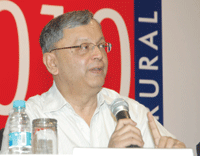Summiya Yasmeen interviewed Madhav Chavan, the Mumbai-based founder chief executive of Pratham (estb.1994), which has compiled and published the Annual Status of Education Report 2010, by e-mail. Excerpts:
 Congratulations on the uninterrupted publishing of your sixth ASER report. However the conclusions of ASER 2010 are somewhat depressing.
Congratulations on the uninterrupted publishing of your sixth ASER report. However the conclusions of ASER 2010 are somewhat depressing.
On the enrolment front, they are encouraging and some states have shown improvement in children’s reading ability to some extent. But considering that almost half of children who enroled in class I in 2005 have now completed class V but still can’t read class II texts, the learning outcomes in most states are disappointing.
Over the past five years since the first survey was released, what are the improvements in learning outcomes in rural primary education?
On an India-wide basis they are unchanged. However, in some states — Kerala, Maharashtra and Punjab — the proportion of children who can read has risen by varying percentages. In the northern states, except Himachal Pradesh, there is a decline in the percentage of children who can read fluently. But, the national average remains unchanged. Although the Punjab story is remarkable and Bihar may be excused for declined learning outcomes since it has shown a huge improvement in enrolment, Uttar Pradesh, Rajasthan, Orissa, and Assam have no excuse for the sharp drop in learning outcomes. It is a case of sheer neglect.
In maths, the percentage of children who can do simple sums has declined over the past four years. Pratham changed its testing tool in 2006 and hence the 2010 numbers cannot be compared with 2005. However over the past four years, the proportion of class V children who can solve simple division sums has declined by 8 percent countrywide.
For a country which aspires to economic superpowerdom, this is a very alarming situation. Unfortunately, unlike US President Barack Obama, no Indian leader of national stature seems worried about stagnant learning outcomes in primary education.
What are the bright spots of ASER 2010, if any?
The bright spot in ASER 2010 is clearly Punjab for showing improvement in reading and math learning outcomes for the second year in a row. Over the past three years, Punjab’s Sarva Shiksha Abhiyaan initiative has focused on improving children’s learning outcomes.
The state government strategised and effected necessary changes in classroom pedagogy and monitoring, provided teaching learning material and teacher training to ensure the focus was on children learning. Punjab has shown results in a way that should be an example to the rest of the country.
What are the major factors behind stagnant learning outcomes in government primaries in rural India?
There are four different factors which may operate one at a time or all together. First, there is a preoccupation with construction and provision of supplies. In several states teacher recruitment is another preoccupation. The general thinking is ‘let’s get the infrastructure right and then we will look at learning’.
Secondly there is resistance to measuring learning outcomes. Holistic education is the new mantra. Unfor-tunately there’s an influential lobby in education with complete disregard for learning outcomes and belief in the process rather than the end. But a child who can’t read or do math cannot said to be educated. Thirdly, the poorest and most backward children are concentrated in government schools. Such children don’t have home learning support with their parents being barely literate. The fourth reason is sheer negligence and apathy of state governments.
All these factors combine to ensure that the teacher isn’t motivated or accountable for delivering minimal learning outcomes. What is true of rural India is also true, perhaps more true, of urban — especially small town — schools in India.
ASER 2010 indicates that learning outcomes in private rural schools are better than in government schools. What’s your comment?
The short answer is that learning outcomes in private schools are 8-10 percentage points better than in government schools. But, the quality of private schools varies from state to state. In most states, if you factor in family income, parents’ education, etc the difference between learning outcomes of private and government schools is negligible.
The RTE Act prohibits detaining of children upto class VIII and doesn’t specify minimum learning outcomes for children leaving primary school. Will this contribute to learning outcomes plummeting further?
Detaining a child for failures of the system is wrong. But promoting her without improving learning is not helpful either. There is good reason to believe that learning of basic skills will be negatively affected because of diluted accountability on all sides. No detention is only acceptable if the school and teacher are made responsible for ensuring that basic learning happens with external assessment.
ASER 2010 is the sixth report on the status of elementary education in India. What is the response of the central government to the aser initiative and in particular its findings?
There is no real response from government. However, the vice president of India released the report and in his speech emphasised the importance of learning outcomes and need for measurement. This is a clear endorsement of our work. Union HRD minister Kapil Sibal also invited the ASER team for a 45-minute discussion.
In the states, ministers, governors, and education officials have released state reports and tried to understand where they stand. If the Union government takes the lead, then things will move fast but we are not sure whether Sibal or the prime minister will take the initiative given the prevailing political atmosphere.